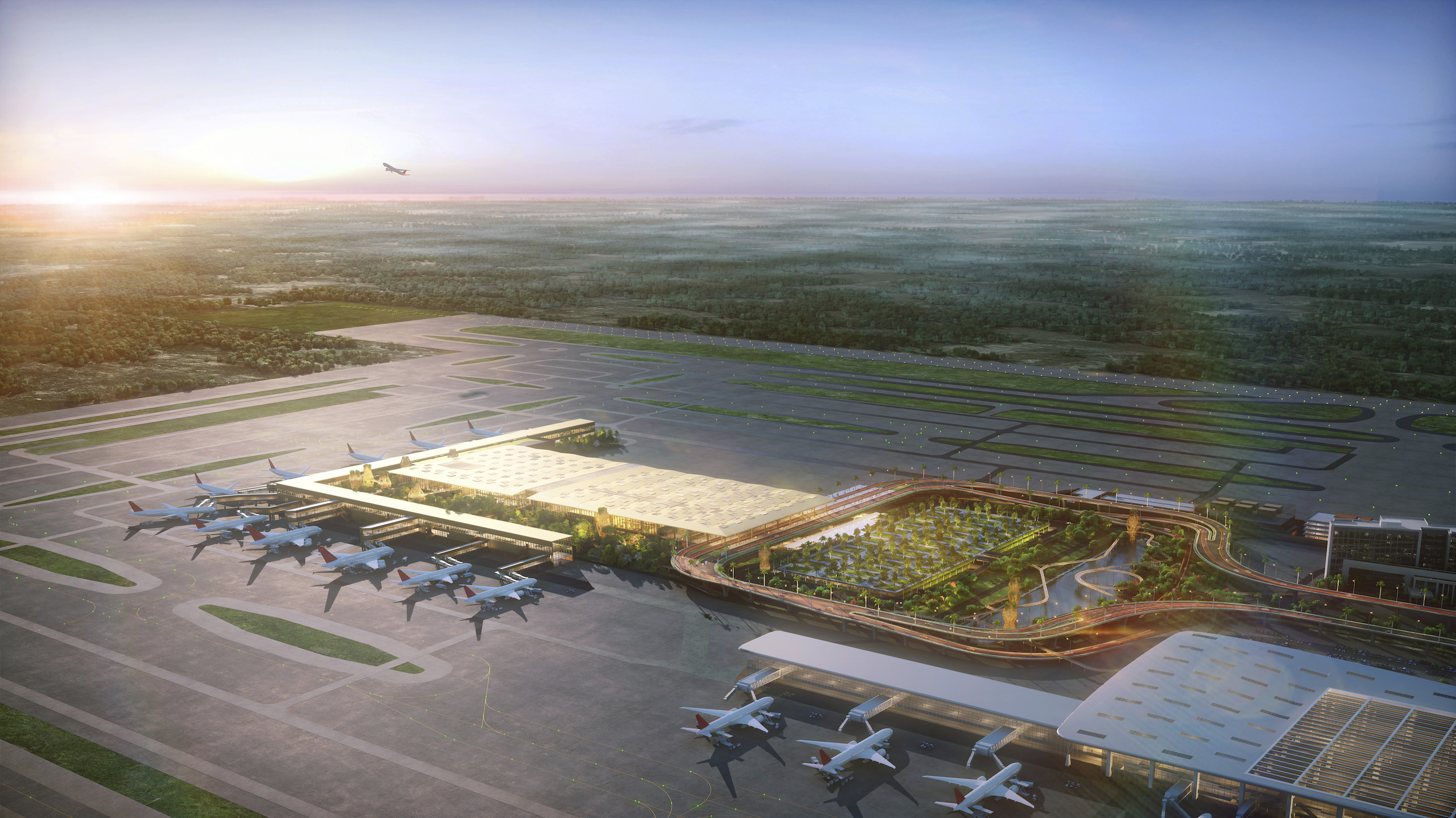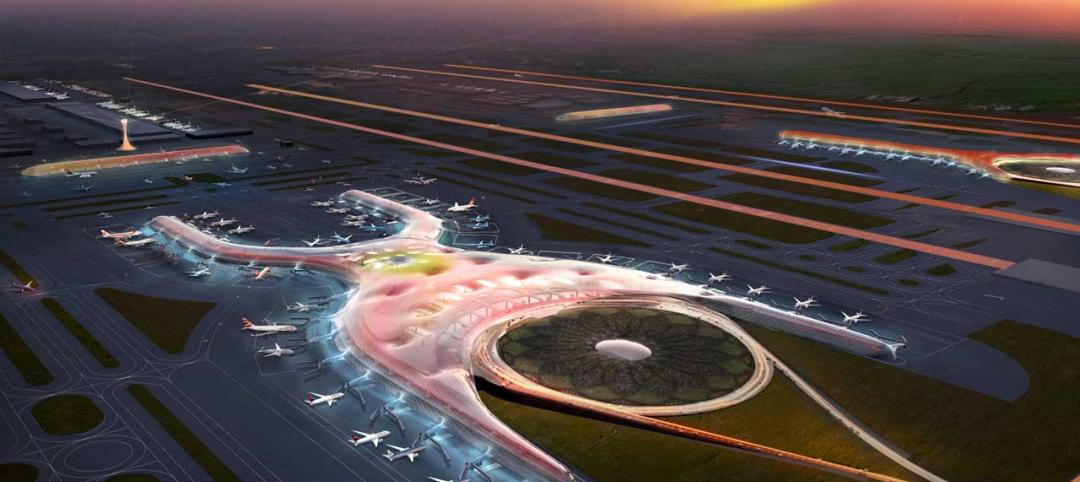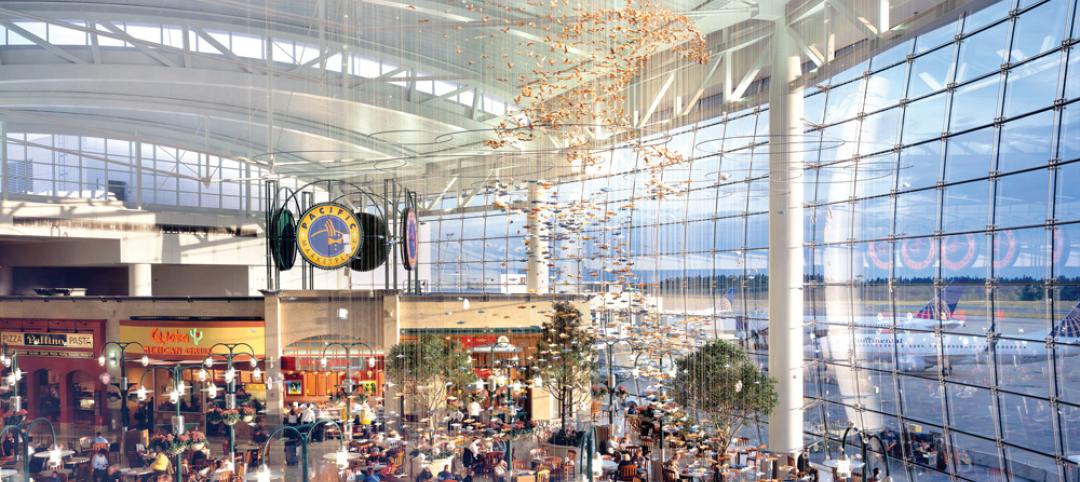Incorporating biophilia into a building’s architectural design has found its fullest expression lately in airports. Setting the bar when it opened in 2019 was the nature-themed Jewel Changi Airport, designed by Safdie Architects, which features an expansive indoor forest and a rain-fed waterfall that, at 40 meters, is the world’s tallest.
On January 15, 2023, Phase 1 of the Kempegowda International Airport’s Terminal 2, in Bengaluru, India, began domestic operations. The 255,661-sm (2.75 million-sf) building, designed by Skidmore, Owings & Merrill (SOM), is projected to process 25 million passengers annually, while providing its travelers with a healthier environment, thanks to extensive indoor-outdoor landscaping that offers serenity to what is normally a frenzied experience.
Phase 1 of Terminal 2 “allows for a sense of wonder and delight” with its outdoor gardens and exotic plants, says Peter Lefkovits, a Partner with SOM, whom BD+C interviewed a few weeks after the terminal opened. The building team on this project included the structural, civil, and facade engineer Buro Happold, which also provided structural and façades engineering services for the Jewel Changi Airport.
Airport terminal offers a natural connection to the outdoors
SOM’s involvement in the Kempegowda Airport project dates back to 2013, when it won a design competition. It worked with Arup on this project's MEP design. Lefkovits recalls that the client, Bangalore International Airport Ltd. (BIAL), “from the get-go” wanted its new terminal to reflect Bengaluru, known locally as the Garden City for its lush parks and gardens, and temperate climate despite being in southern India.
“We give the airport a lot of credit for its vision for a model of sustainability, even pre-pandemic,” says Lefkovits.
Working with the landscape architect Grant Associates and the lighting consultant Brandston Partnership Inc., SOM devised a terminal within a garden that connects passengers to nature. Travelers walking through the airport are exposed to more than 10,000 sm of green walls, hanging plants, and gardens inside a terminal whose buildings are interconnected by a continuous band of outdoor landscaped spaces.
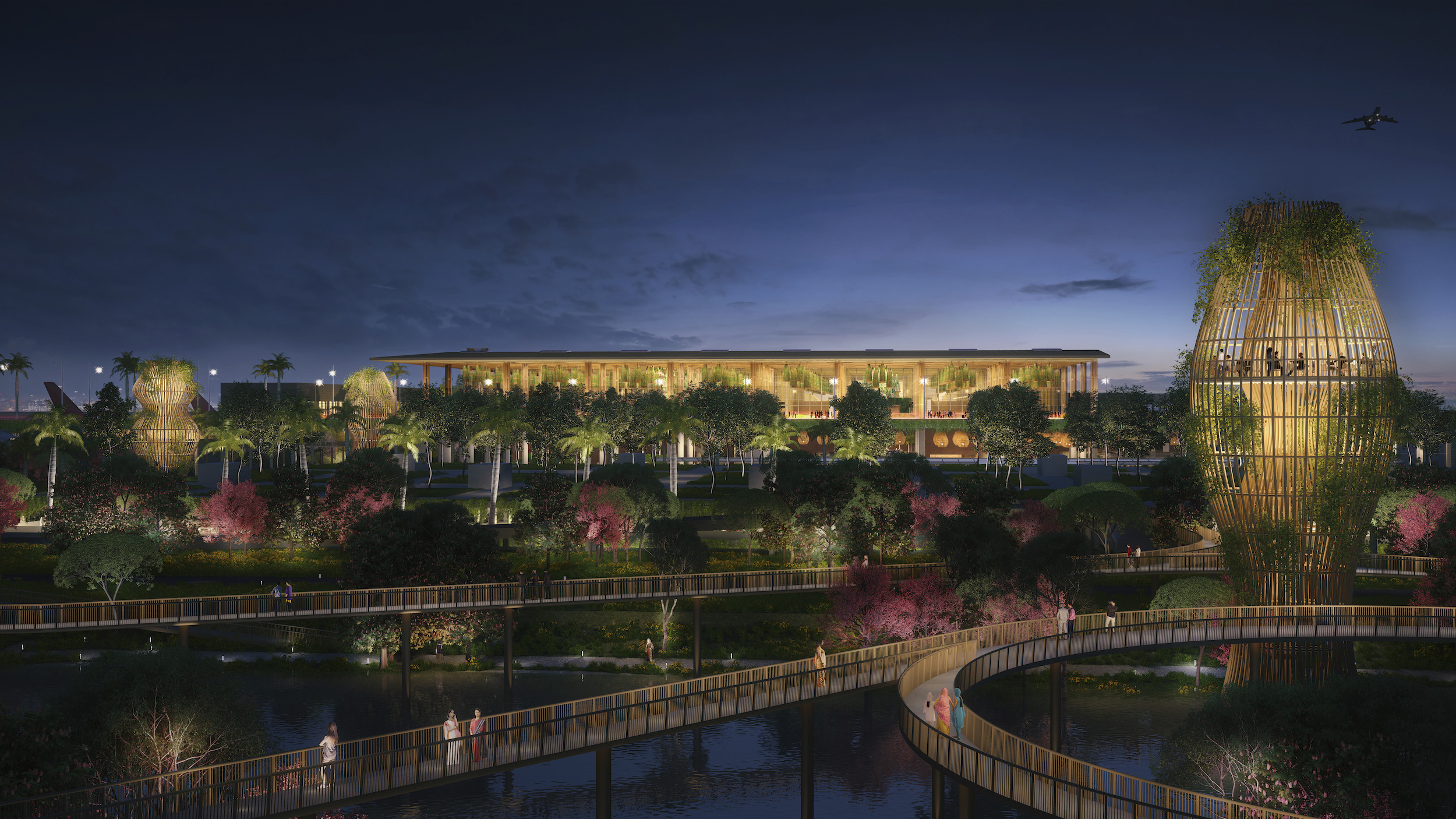
The main complex—which encompasses areas for check-in, baggage dropoff, and security checkpoints—is linked to an 11-gate boarding building by an outdoor, 24,000-sm “forest belt” that rises three stories and includes a series of open-air bridges for departures (upper floor) and arrivals (lower floor). Lefkovits notes that there’s a separate network of walkways that allows passengers to meander through the forest.
The outdoor garden surrounds a large lagoon that supports a nursery for maintaining the terminal’s plant life and provides graywater for the terminal’s operations.
The plant species throughout the terminal were chosen for their ruggedness. The flora has its own integrated irrigation system that is monitored by apps. Lefkovits adds that the plants were often placed to take advantage of the terminal’s skylights.
Bamboo abounds as a design feature of the airport terminal
From Day 1, the Building Team, which included the general contractor Larsen + Toubro and CM Turner Construction, worked under a specific budget that was set by regulatory authorities. Consequently, the building’s design is clean, efficient, and simple, Lefkovits says, without “structural gestures” and at the service of the gardens and passenger comfort.
The team used a “rich palette” of building materials that included domestic granite for the terminal’s flooring, and natural brick for its walls. “It doesn’t feel like an airport as much as a hotel,” says Lefkovits.
Contributing to that ambiance within the terminal is an abundance of hanging plants and natural light that filters through bamboo lattice. Indoor waterfalls in the building’s retail section help cool the interior. Terminal 2 also has one of the lightest roofs at this scale, made entirely from domestically produced materials. The roof above the retail and check-in halls features long-span steel frames supported by steel columns 18 meters apart, whose posts are clad in bamboo.
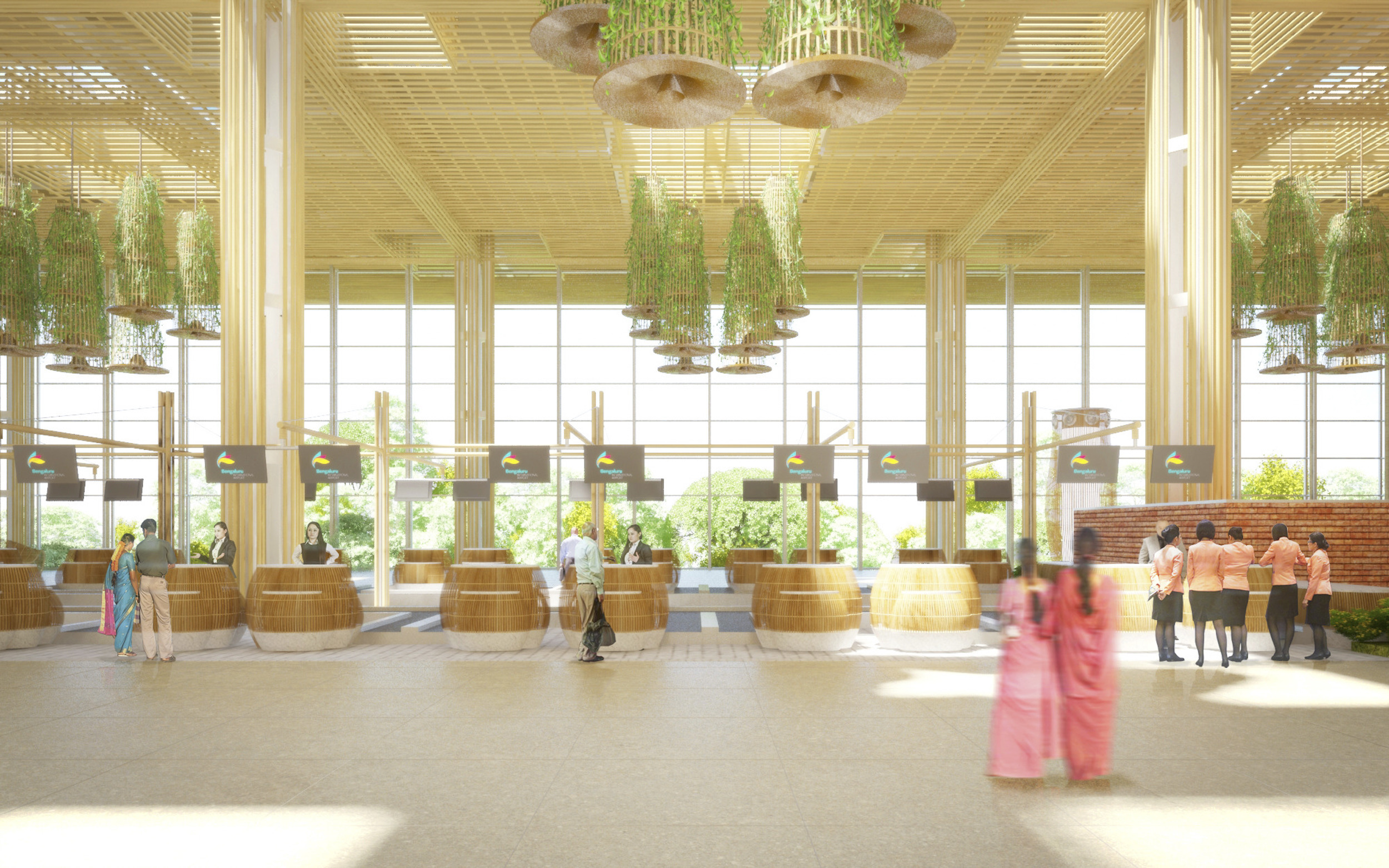
At the center of Kempegowda Airport, with Terminal 2 to its north and Terminal 1 to its southeast, is a 123,000-sm, T-shaped multimodal transit hub, the artery through which the entire complex can be accessed. As if a terminal within a garden isn’t unusual enough, the transit hub features an outdoor retail and entertainment area that the airport has positioned as a new civic center for the city. The gardens from Terminal 2 extend to the hub and its surrounding land. Two lagoons on the hub’s southern side recycle the airport’s stormwater runoff.
Related: BD+C's 2022 Airport Terminal Giants:
• Top 55 Airport Terminal Architecture and AE Firms
• Top 65 Airport Terminal Engineering and EA Firms
• Top 60 Airport Terminal Contractors and CM Firms
India’s Ministry of Civil Aviation estimated that Terminal 2 cost “around” 50 billion rupees to build, or the equivalent of US$604 million. Terminal 2 was designed and constructed to achieve LEED Gold certification. The building is run entirely on renewable energy. The terminal’s second phase, for which no start date has been announced yet, will increase its size to 450,000 sm, and its annual traveler capacity to 40 million.
Related Stories
| Sep 22, 2014
Sound selections: 12 great choices for ceilings and acoustical walls
From metal mesh panels to concealed-suspension ceilings, here's our roundup of the latest acoustical ceiling and wall products.
| Sep 15, 2014
Ranked: Top international AEC firms [2014 Giants 300 Report]
Parsons Brinckerhoff, Gensler, and Jacobs top BD+C's rankings of U.S.-based design and construction firms with the most revenue from international projects, as reported in the 2014 Giants 300 Report.
| Sep 9, 2014
Using Facebook to transform workplace design
As part of our ongoing studies of how building design influences human behavior in today’s social media-driven world, HOK’s workplace strategists had an idea: Leverage the power of social media to collect data about how people feel about their workplaces and the type of spaces they need to succeed.
| Sep 8, 2014
First Look: Foster + Partners, Fernando Romero win competition for Mexico City's newest international airport
Designed to be the world’s most sustainable airport, the plan uses a single, compact terminal scheme in lieu of a cluster of buildings, offering shorter walking distances and fewer level changes, and eliminating the need for trains and tunnels.
| Sep 3, 2014
New designation launched to streamline LEED review process
The LEED Proven Provider designation is designed to minimize the need for additional work during the project review process.
| Sep 2, 2014
Ranked: Top green building sector AEC firms [2014 Giants 300 Report]
AECOM, Gensler, and Turner top BD+C's rankings of the nation's largest green design and construction firms.
| Sep 1, 2014
Ranked: Top federal government sector AEC firms [2014 Giants 300 Report]
Clark Group, Fluor, and HOK top BD+C's rankings of the nation's largest federal government design and construction firms, as reported in the 2014 Giants 300 Report.
| Aug 19, 2014
HOK to acquire 360 Architecture
Expected to be finalized by the end of October, the acquisition of 360 Architecture will provide immediate benefits to both firms’ clients worldwide as HOK re-enters the sports and entertainment market.
| Aug 11, 2014
Air Terminal Sector Giants: Morphing TSA procedures shape terminal design [2014 Giants 300 Report]
The recent evolution of airport terminals has been prompted largely by different patterns of passenger behavior in a post-9/11 world, according to BD+C's 2014 Giants 300 Report.
| Aug 6, 2014
25 projects win awards for design-build excellence
The 2014 Design-Build Project/Team Awards showcase design-build best practices and celebrate the achievements of owners and design-build teams in nine categories across the spectrum of horizontal and vertical construction.


